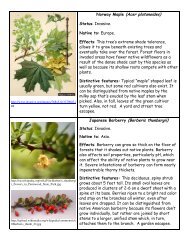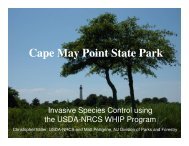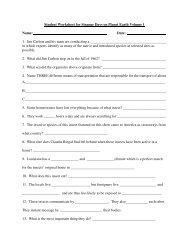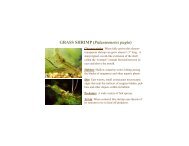Invasive Species in the Barnegat Bay Region - Georgian Court ...
Invasive Species in the Barnegat Bay Region - Georgian Court ...
Invasive Species in the Barnegat Bay Region - Georgian Court ...
You also want an ePaper? Increase the reach of your titles
YUMPU automatically turns print PDFs into web optimized ePapers that Google loves.
5/1/2013<br />
http://www.flickr.com/photos/plant_diversity/3768272782/<br />
<strong>Invasive</strong> Weeds<br />
Spotted Knapweed (Centaurea<br />
maculosa)<br />
• Dist<strong>in</strong>ctive black tips on flower<br />
bracts give species its name.<br />
• Produces huge number of seeds<br />
and is spread<strong>in</strong>g rapidly <strong>in</strong> NJ and<br />
beyond.<br />
• Grows <strong>in</strong> variety of habitats<br />
where it outcompetes native<br />
species<br />
• Also harms soil and water by<br />
<strong>in</strong>creas<strong>in</strong>g erosion, surface<br />
runoff, and stream<br />
sedimentation<br />
http://upload.wikimedia.org/wikipedia/commons/4/4a/Cirsium_arvense_0.10_R.jpg<br />
http://commons.wikimedia.org/wiki/File:Canada_thistle_cirsium_arvense_144a.JPG<br />
<strong>Invasive</strong> Weeds<br />
Canada Thistle (Cirsium arvense)<br />
• 1 – 4 feet tall with sp<strong>in</strong>y, lobed<br />
leaves and many small, purplish<br />
flower heads<br />
• Highly <strong>in</strong>vasive, it outcompetes<br />
native plants <strong>in</strong> open habitats such<br />
as barrens, sand dunes and<br />
meadows<br />
Asiatic Sand Sedge<br />
• Lower stature<br />
• Much denser growth pattern<br />
• Outcompetes native plants<br />
• Not eaten by native animals<br />
• Forms lower, wider dunes<br />
<strong>Invasive</strong> Aquatics<br />
Eurasian water-milfoil (Myriophyllum<br />
spicatum)<br />
• Grows mostly <strong>in</strong> lakes and ponds<br />
• Starts grow<strong>in</strong>g earlier <strong>in</strong> spr<strong>in</strong>g than<br />
native aquatic plants,<br />
• Quickly forms dense canopy that<br />
outcompetes surround<strong>in</strong>g vegetation<br />
• Lower food value to waterfowl than<br />
native plants<br />
• Supports fewer <strong>in</strong>vertebrates so affects<br />
fish too<br />
• Water quality and dissolved oxygen<br />
decl<strong>in</strong>es due to decay of thick vegetation<br />
Curly-leaf pondweed<br />
(Potamogeton crispus)<br />
<strong>Invasive</strong> Aquatics<br />
• Usually first macrophyte to<br />
emerge <strong>in</strong> spr<strong>in</strong>g, but dies back<br />
by July<br />
• Capable of rapid growth and<br />
spread<br />
• Can displace native species,<br />
reduce biodiversity, impede<br />
recreational activities and<br />
decrease water quality<br />
<strong>Invasive</strong> Animals of <strong>the</strong> <strong>Barnegat</strong><br />
<strong>Region</strong><br />
Green crab<br />
Asian shore crab<br />
Mute Swan<br />
Harlequ<strong>in</strong> Ladybug<br />
Beetle<br />
Starl<strong>in</strong>g<br />
Japanese Beetle<br />
6







